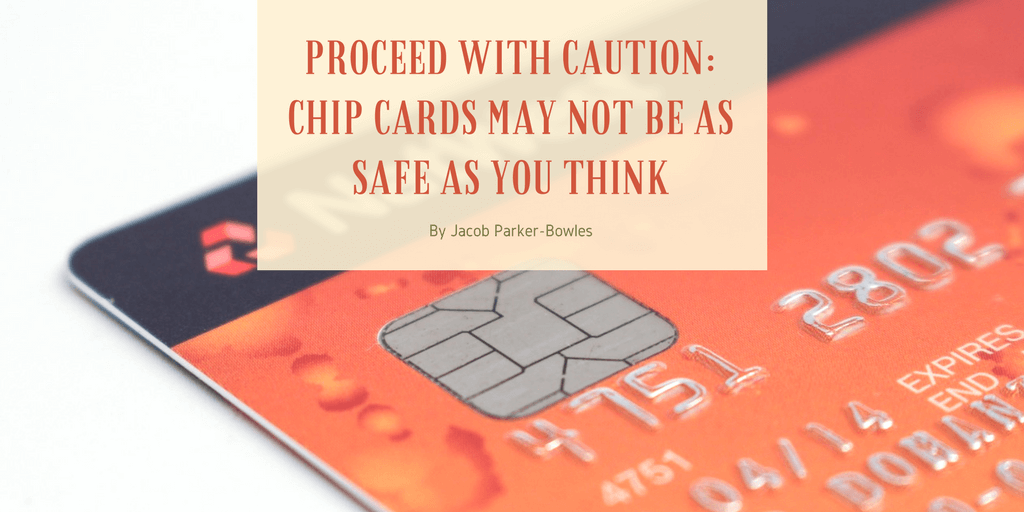If you’re an American that’s still swiping your credit card when you go to make purchases because you don’t have the chip yet, you’re actually in the minority. According to a recent poll, 70 percent of U.S. credit card holders now carry EMV chip cards. If you have one already, you may have breathed a sigh of relief when your new card arrived in the mail, knowing that you could finally cut up your old swipe card and start adopting this safer system. But before you get too excited and let your guard down, know this: while credit cards embedded with EMV chips are generally safer than the old magnetic stripe cards, they are not flawless.
Here’s why, when used properly, the chip technology is much safer than the traditional swipe method: The small, metallic square that’s on the face of new cards contains a computer chip. In contrast to magnetic stripes, which store unchanging data, the computer chips create unique transaction codes each time they’re used. So if someone were to steal the information from a specific point of sale, they would not be able to profit from it, as the stolen transaction number would not be used again and the card would be declined. The hope, with converting to EMV chip card in the United States, is that fraud will be significantly reduced, to be at a level with countries that have already adopted the EMV technology. According to Julie Conroy, retail banking research director at Aite Group, “The introduction of dynamic data is what makes EMV cards so effective at bringing down counterfeit card rates in other countries.”
Both in theory and in practice, chip cards seem to be an ideal solution to credit card fraud. According to reports from Mastercard and Visa, counterfeit rates in the United States have already decreased significantly. Visa saw a 52 percent decrease in fraud through chip-enabled merchants, while Mastercard recorded a 54 percent decrease. Conversely, Mastercard found that merchants who had not yet transitioned to the new technology had a 77 percent increase in credit card fraud. As this statistic demonstrates, not all of the pieces have fallen into place yet for the transition from magnetic stripe to chip cards, so fraud remains.
While most Americans have already converted to using chip cards, retailers are much slower to roll out the new system. So you may possess a chip card, but that doesn’t mean you’ll be able to use the chip feature everywhere- hence why this first round of chip cards issued to U.S. cardholders contains magnetic strips as well. As of December 2016, only 39 percent of U.S. stores (approximately 1.81 million locations) are equipped to accept chip cards. Yet, in January 2017, the U.S. Payments Forum estimated that 9 out of 10 Americans regularly use chip cards at the retail locations that accept them.
This disconnect between cards equipped with EMV chips and the retailers accepting them is the source of a major security concern. The issuance of chip cards has skyrocketed since the October 1, 2015 EMV fraud liability shift deadline, and as a result, the liability for some credit card fraud has shifted from card issuers to merchants unequipped to process the new cards.
Another reason chip cards in the Unites States are still not as safe as they could be is that consumers are not required to enter a PIN at the point of sale to verify their identity, unless they are using a debit card. Instead, they only require an electronic signature. “We all know that nobody verified signatures,” said Martin Ferenczi, president of EMV card manufacturing company, Oberthur Technologies. In Europe, card holders have an added layer of security by entering PIN numbers for each transaction, but that is not yet the case in America where customers are accustomed to entering their signature. If a card is physically stolen, the chip would not alert the merchant to unlawful use and additionally, there is no protection for purchases made online or over the phone.
Ultimately, even though some U.S. card suppliers offer both signature and PIN capabilities, finance experts hope that soon, we will be able to move away from a technology that relies on static numbers altogether. EMV chips offer no protection for online purchases, where a vast number of purchases are now made. The hope is that the finance sector will implement other, more advanced form of verification, such as biometrics, mobile verification, and tokenization, a system that would use a placeholder number to retrieve data from a customer rather than storing their credit card information.
It is apparent that EMV chip credit cards will have to sort out some bumps in the road on the way to becoming a more reliable model, but the field of financial technology is volatile and exciting- a few years from now, we could be using another form of payment entirely.

